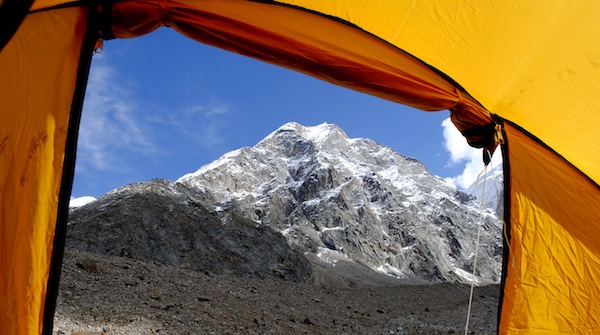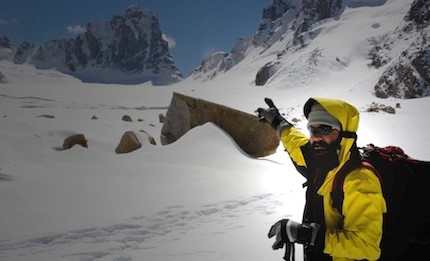The base camp of the Chhota Shigri glacier – one of the few glaciers monitored regularly in the Indian Himalayas – stands amidst stones, where once ice flowed 50 metres thick

The Chhota Shigri base camp offers a breath-taking view of the northern ridge of the Pir Panjal range in the Indian Himalayas that reach up to 6,500 metres (21,325 feet). Lateral moraines, the accumulation of boulders and stone deposited by a glacier, form parallel ridges about 50 metres high and 170 metres wide.
I was at the base camp in autumn 2013 after a gap of around three years. A huge chunk of ice in the mountain across the Chandra river still hangs. Anurag Linda, glaciologist at the Central University of Himachal Pradesh, has been visiting the place since 2002 and has seen the huge chunk of ice holding the mountain so tight for more than a decade. It is a hanging glacier.
This Lahaul-Spiti area of Himachal Pradesh is a cold desert. Sitting on the ridge, the dusty road up appears as a thin line on a distant mountain, the only evidence of human existence for miles. The river and the wind provide the only sound.
Once, there was a glacier here
Investigations through expeditions and mapping of the Chhota Shigri, Patsio and Samudra Tapu glaciers in the Chenab basin, the Parbati glacier in the Parbati basin and the Shaune Garang glacier in the Baspa basin have shown an overall reduction in the glacier ice mass of 21% from 1962 to 2001, said a study reported in Current Science in 2007.

This retreat can heavily impact the freshwater regime. A significant portion of the low flow contribution of Himalayan rivers during the dry season is from snow and glacier melt in the region. In South Asia, the cryosphere (glaciers and snow) provides up to 80% of the dry season flows of the Indus, Ganga and Brahmaputra river systems through their vast irrigation network, says UNESCO, though the International Centre for Integrated Mountain Development and many research organisations associated with the Indian government have given far lower figures.
Studies have shown that an accelerated retreat of the glaciers in recent times has led to an enlargement of several glacial lakes. In the last five decades, the Himalayan region has faced some glacial lake outburst floods, leading to the loss of lives and property. For an energy-constrained economy like India, the prospect of diminishing river flows in the future and the possibility that energy potential from hydropower may not be achieved has serious economic implications. Reduced irrigation for agriculture would have ramifications not only on crop production but eventually on food supplies for people.
Past, present and future
In the nearby hill ranges, hundreds of trees have been planted to prevent landslides by the environment and forests department of the state government. But this forestry initiative has merely shifted the landslide-prone area to adjacent ridges, which were never prone to such incidents in the past. Now at the base camp, near the glacier which once saw mostly snowfall, it rains more than ever. Those hundreds of trees could be a possible reason why clouds now form on the hills; the winds then carry them forward in this narrow valley.
It is not merely changes in the nearby surroundings; incidents more than 4,000 kilometres away have also left footprints on the glacier. In August 1987, artificial radionuclides were identified in snow samples, confirming the fallout of the Chernobyl nuclear disaster on the Chhota Shigri glacier. This needs further investigations.
It has been evident for many years that the snout of the glacier is retreating. The glacier is melting faster than it is accumulating ice at the top, showing what scientists call negative mass balance. But the scientific evidence for this has been built only in the last couple of decades. In 1987, the radiometric age – the approximate age of a geologic event, feature, fossil, or rock in years – of the ice at the snout was calculated as 250 years. A study conducted between 2002 and 2005 revealed that the glacier is likely to become thinner at lower altitudes, with the impact of global warming.
Food for thought
A recent inventory by the Geological Survey of India has revealed the existence of 9,575 glaciers in the Indian part of the Himalayas. Very few glaciers in the region have been monitored constantly in recent years. Chhota Shigri is one of the three that has been monitored regularly and the information has been made available in the public domain.
Climate change and its impacts on the melting rate of glaciers are a natural phenomenon that has occurred during the earth’s five billion-year-old history. But in the past few decades, human induced climate change has also had a significant impact on the high mountain environment. Snow, glaciers and permafrost are especially sensitive to changes in atmospheric conditions because of their proximity to melting conditions. For water-stressed India and the rest of the South Asian region, glaciers have an everlasting impact on lives, livelihoods and future.
According to Wilfried Haeberli and Martin Hoelzle of the World Glacier Monitoring Service, the measurements taken over the last century “clearly reveal a general shrinkage of mountain glaciers on a global scale.” They observed that the trend was most pronounced during the first half of the twentieth century and that glaciers had started to grow again after about 1950. However, they say that mountain glacier retreat has been accelerating again since the 1980s at a “rate beyond the range of pre-industrial variability.”
This is a complex and dynamic phenomenon. Even within the history of mankind, the earth has undergone profound changes but it is difficult to trace patterns with data from just a couple of decades. The recent installation of Automated Weather Stations (AWS) in the high Himalayas may give accurate datasets in the upcoming years. Even so, the trends of some decades cannot be projected as representative for patterns going back hundreds of centuries.
